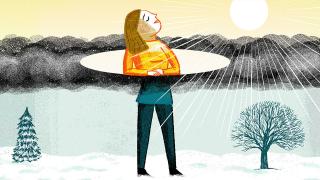DIAGNOSING AND TREATING SEASONAL AFFECTIVE DISORDER
Well, it looks like winter will be here for a while.
And with the coronavirus pandemic still raging, these colder and darker months can be especially trying, particularly for those who suffer from Seasonal Affective Disorder, a type of depression related to changes in seasons. Most who suffer from SAD start to feel symptoms, which can range from low energy to mood swings, in the fall and continue through the winter months. It also is possible to experience SAD in the spring or early summer. It’s important to take seriously this condition and its related symptoms, avoiding chalking them to nothing but the “winter blues.”
In the fall and winter, symptoms can include sleeping late, craving foods high in carbohydrates, gaining weight and feeling tired throughout the day. Symptoms are a bit different among those who experience SAD in the spring and summer; those can range from anxiety to insomnia to weight loss.
Causes of Seasonal Affective Disorder
While there isn’t a clear-cut cause of SAD, a number of factors may come into play, including the reduced level of sunlight, which can disrupt your body’s biological clock and can lead to feelings of depression. Reduced sunlight also can result in a drop in serotonin, a brain chemical that affects mood, triggering depression. Melatonin levels also can be disrupted by the change in seasons, altering sleep patterns and mood.
SAD is diagnosed more often in women than men and it appears to occur more frequently in younger adults than those who are older. Individuals who are at higher risk include those with a family history of SAD or another form of depression. People who suffer from bipolar disorder or major depression can see those symptoms worsen depending on the season.
How to Fight SAD
There are a number of ways to combat these symptoms, which is going to be especially important over the coming months as winter doesn’t officially end until March 20 and Daylight Savings starts just before that on March 14. Some of the tools available to manage SAD include:
- Wake up to a dawn simulator. This is an alarm clock that uses light instead of an alarm to wake up users. Instead of beeping or music, these devices produce light that gradually gets brighter over a period of time, replicating a sunrise.
- Make a commitment to getting outside. Even if it means bundling up, it’s important to get outside and take advantage of what sunlight is available. And when inside, keep the window blinds open, allowing as much natural light as possible into your space.
- Seek help. Talking to a mental health professional can help determine a course of treatment, which could include outpatient group therapy or prescription antidepressants. The mental health professionals at Willow Creek Behavioral Health treat individuals who experience mental health challenges, like trauma, grief, depression, anxiety and suicidal thoughts and behaviors. Call us 24/7 at (888) 464-1498 or toll free at (844) 308-5050.






